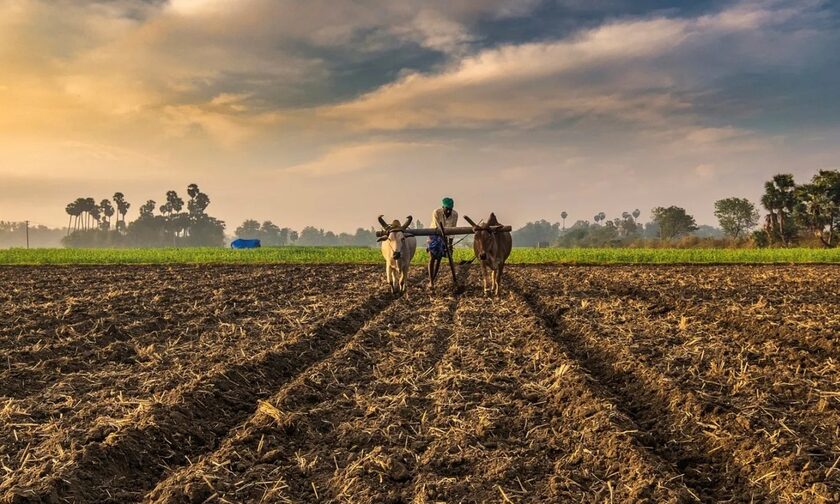Emerging Growth Dynamics of Agriculture Sector in India

The transformative journey of Indian agriculture, transitioning from scarcity to surplus, is marked by significant milestones highlighting its adaptability
India’s agriculture GDP grew 144% in the last 10 years as compared with 148% of services sector and 128% of industry. India is a 14th largest exporter of agriculture products in the World, 3rd largest in Asia and a largest exporter of agriculture products in South Asia.
Agriculture stands as the cornerstone of India's economy, with its substantial 20% share in the GDP and the employment of nearly 45% of the workforce, showcasing remarkable resilience and importance. Despite the formidable challenges posed by the Covid-19 pandemic and other economic upheavals, the agricultural sector has demonstrated steadfastness, ensuring food security and making significant strides in its growth.
The transformative journey of Indian agriculture, transitioning from scarcity to surplus, is marked by significant milestones highlighting its adaptability. The Green Revolution, a pivotal chapter in India's agricultural narrative, substantially bolstered agricultural productivity, notwithstanding occasional fluctuations. However, recent trends deviate from this erratic pattern, with the sector consistently expanding at an impressive rate exceeding 3% over the past four years (2019-2023). This sustained growth owes to a combination of factors, including technological advancements, infrastructural improvements, knowledge dissemination, robust policy initiatives, and a focused approach to climate resilience.
The tangible evidence of this advancement is apparent in the remarkable rise in food grain production, which escalated from 257 million tonnes in the fiscal year 2013 to an impressive 309 million tonnes in 2023. This not only underscores the sector's potential for consistent expansion but also emphasizes its crucial role in ensuring food security for the growing population. Moreover, this increased production has set the stage for a gigantic increase in agricultural exports, climbing from a modest 5 billion USD in 2001 to a remarkable 53 billion USD 2023. Such a positive trend has firmly established India as a significant player in the global agricultural market.
With approximately 45% of India's workforce engaged in agriculture, this sector continues to play a vital role in offering livelihood opportunities, particularly in rural regions. Progressive government initiatives, along with advancements in agricultural technology and infrastructure, have not only boosted agricultural output but have also spurred employment prospects in related fields. The rise of agribusinesses, logistics, and rural infrastructure projects has diversified employment options, promoting inclusive growth and sustainable development in rural communities.
Prioritizing job creation within agriculture has not only improved the socio-economic well-being of rural populations but has also contributed to the nation's overall development. Through initiatives aimed at skill development and the promotion of sustainable agricultural practices, the sector has effectively empowered rural communities, raising their living standards and fostering inclusive growth.
The incorporation of advanced technologies into farming necessitates skilled labor for operating and maintaining sophisticated machinery, thereby generating employment opportunities in agricultural technology and research. As the agriculture sector expands, it spurs demand for related support services such as agricultural extension services and financial institutions offering agricultural loans, consequently fostering job creation and promoting overall rural economic development. Governments can harness the potential of the agriculture sector to drive employment generation and uplift rural communities by creating a conducive environment for agricultural growth and investing in rural infrastructure and skill development.
Sectoral share in GVA at Current Prices
Sector | 2013-14 | 2023-24 | Increase in GDP (%) |
Agriculture | 1926372 | 4692360 | 144 |
Industry | 2930716 | 6698141 | 128 |
Services | 6167380 | 15287177 | 148 |
In the Indian economic landscape, the past decade has been marked by significant strides across various sectors. Agriculture, a cornerstone of India's economy, has seen a commendable increase of 144% in Gross Value Added (GVA). This growth underscores the adoption of modern agricultural practices and technological advancements, empowering farmers and enhancing productivity.
The Industry sector has witnessed a robust surge of 128%, reflecting India's progress in manufacturing, infrastructure development, and industrial innovation. This growth trajectory aligns with the nation's ambitions of becoming a global manufacturing hub and fostering sustainable industrial growth. Moreover, the Service sector, a key driver of India's economic expansion, has demonstrated remarkable resilience and dynamism with a significant increase of 148% in GVA. This surge highlights the country's evolving service-oriented economy, characterized by advancements in IT, finance, healthcare, and other services.In the realm of agricultural prowess, India boasts the world's largest population of cattle (including buffaloes) and holds the top position globally in milk, pulses, and spice production. Additionally, India ranks second globally in the production of fruits, vegetables, tea, farmed fish, cotton, sugarcane, wheat, rice, and sugar. India's agricultural sector ranks second globally in terms of agricultural land, providing employment for nearly half of the country's population. Furthermore, it serves as a leading exporter of various commodities, including basmati rice, sugar, cereals, spices, buffalo meat, marine products, and more
Top 20 Agriculture Exporters in the World (In USD Billion)
S.No | Countries | 2022(USD Billion) |
1 | European Union | 799 |
2 | United States of America | 222 |
3 | Brazil | 148 |
4 | Netherlands | 135 |
5 | Germany | 108 |
6 | China | 96 |
7 | Canada | 91 |
8 | France | 91 |
9 | Spain | 75 |
10 | Indonesia | 71 |
11 | Italy | 66 |
12 | Belgium | 63 |
13 | Australia | 56 |
14 | India | 54 |
15 | Argentina | 53 |
16 | Poland | 53 |
17 | Thailand | 52 |
18 | Mexico | 52 |
19 | Russian Federation | 46 |
20 | Malaysia | 41 |
In the realm of global agricultural trade, India commands a significant position as the 14th largest exporter in the World, boasting an impressive export value of USD 54 billion. This places India firmly among the top 20 exporters worldwide. Despite challenges, including fluctuating market conditions and logistical complexities, India's agricultural sector continues to demonstrate resilience and competitiveness at the global stage.
With its rich agricultural heritage and diverse range of produce, from grains and fruits to spices and beverages, India caters to a broad spectrum of international markets. This not only fuels economic growth but also supports the livelihoods of millions of farmers and rural communities across the country.
Allied sectors of agriculture significantly contribute to employment in India through diverse avenues. The agro-processing industry, which includes activities such as food processing, packaging, and storage, generates employment opportunities for individuals involved in food manufacturing and distribution. Additionally, the agricultural input sector, covering the production and distribution of seeds, fertilizers, and pesticides, offers employment for workers engaged in manufacturing, sales, and distribution networks. Moreover, the agri-logistics sector, responsible for the transportation, warehousing, and distribution of agricultural products, creates jobs transportation, warehousing, and logistics.
Furthermore, agricultural extension services, provided by professionals offering technical advice and support to farmers, contribute to employment by deploying agricultural advisors and technicians. By fostering growth in these allied sectors, the agriculture sector in India plays a crucial role in stimulating employment across various interconnected domains, thereby promoting overall economic development and sustainability.
India's agriculture sector serves as a beacon of resilience, adaptability, and economic significance, deeply ingrained in the nation's fabric. As this vital sector continues its evolutionary journey, it becomes imperative for stakeholders, policymakers, and communities to redouble their efforts towards its holistic development. By embracing technological innovations, championing sustainable practices, and fostering an enabling policy environment, India can unlock the full potential of its agriculture sector, laying a robust foundation for economic growth and ensuring food security for generations to come.
Beyond its economic contributions, agriculture embodies the essence of the Indian ethos, representing a source of hope and prosperity for millions. It is not merely a sector of the Indian economy but a way of life, intricately linked with traditions, culture, and heritage. In nurturing and advancing agriculture, India sustains its roots while embracing the future, driving the nation forward on the path of progress and resilience.
With a collective commitment to the well-being of farmers, sustainable land management, and inclusive growth, India can navigate the challenges ahead and emerge stronger, with agriculture leading the charge towards a brighter, more prosperous future for all.













